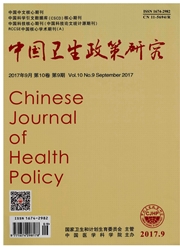

 中文摘要:
中文摘要:
目的:评价中国女性使用乳腺超声、钼靶X线和不筛查三种乳腺癌筛查方式的成本效果和成本效用。方法:采用中国数据,建立Markov决策模型,对每年进行一次乳腺超声筛查、每年进行一次钼靶X线筛查和不筛查的40岁以上女性进行终生队列模拟,以3%贴现率进行贴现。以不筛查组的成本和效用作为基线得到增量成本效用比,并使用单因素敏感度分析和概率敏感度分析验证模型的稳健性,同时对中东西部地区和不同类型城市进行亚组分层分析。结果:与不筛查相比,乳腺超声筛查和钼靶X线筛查的增量成本效用比分别为102 653元/QALY和201 309元/QALY。概率敏感度分析结果显示,乳腺超声和钼靶X线具有成本效用的概率分别为54.5%和26.2%。乳腺超声筛查在不同地区和不同类型城市的亚组分析结果无差异,钼靶X线筛查在东部地区的增量成本效用比与意愿支付阈值接近。结论:乳腺超声筛查可考虑作为我国乳腺癌筛查项目的主要方法,但钼靶X线筛查只适合在东部经济较发达地区使用。
 英文摘要:
英文摘要:
Objective: This study aims to analyze the cost-effectiveness and cost-utility of ultrasonography screening, mammography screening and no screening for breast cancer among Chinese women.Methods: A Markov model was developed from a societal perspective among asymptomatic Chinese women over 40 years who are at risk for breast cancer over a lifetime horizon.The decision model was populated with data derived from China, discounted at 3%.After getting the incremental cost-utility ratio (ICUR), this paper explores the parameter uncertainty using one-way sensitivity analysis and probabilistic sensitivity analysis.Subgrouping analysis was conducted based on different city levels and geographical areas in China.Results: Compared to no screening, the incremental cost-utility ratio of ultrasonography screening is ¥102653/QALY and the ICUR of mammography screening is ¥201309/QALY.In probabilistic sensitivity analyses, the probabilities of the ICUR being a threshold of ¥140000/QALY are 54.5% for annual ultrasonography and 26.2% for annual mammography.The subgrouping analysis shows that compared with no screening the ultrasonography screening for breast cancer has high cost-utility in all levels of cities and all geographic areas in China.The ICUR of mammography screening compared with no screening is very close to the threshold in eastern China.Conclusions: Ultrasonography screening could be used as the primary method for breast cancer screening in China, while mammography screening could only be used in economically developed areas in eastern China.
 同期刊论文项目
同期刊论文项目
 同项目期刊论文
同项目期刊论文
 期刊信息
期刊信息
